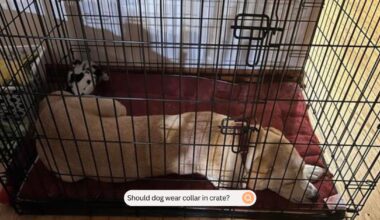About the Author: Nettie Finley, the Professional Dog Trainer at MyPetDoggie. Specializing in behavior rehabilitation, Nettie leads our team with her effective training techniques. As a certified canine behaviorist, she brings transformative change to challenging behavior cases. Her experience and expertise elevate our content, providing practical, insightful training advice for our readers. Also, she loves her Cavapoo!
Losing a fur baby is the worst thing that can happen to any pet parent. I understand because I have been in your shoes and know precisely what you must be feeling right now. By the time you are reading this guide on “How to find a lost dog at night?”, you might have searched all the possible places where your fur baby could have been, and the only thing you found was a disappointment.
But fret not; finding a lost dog becomes relatively easier after 24 hours, so tighten your seat belt and keep your search operation going. Don’t let the darkness outside darken your hope; buckle up to meet your best friend again.
Some of the things you can do to find your lost dog at night are to take help from your friends and neighbors in commencing the search operation, planning a search route, making a trail of your pet’s favorite food item as you search the way will help too.
In this guide, I will provide you with some simple steps you can follow to find your lost dog at night. I will also share answers to some crucial questions you might be having regarding “How to find a lost dog at night?” and will take you through some things you can do to ensure you never lose your fur baby ever again.
You might be interested in: Learn essential tips on keeping your dogs safe during wildfires and evacuation planning.
13 Steps on How To Find A Lost Dog At Night?
I understand that losing your dog at night is scary, but you can’t undone what has already happened. Panicking will only make things worse. But don’t worry, here I have listed all the things you can do that can help you find your lost dog at night.

Step 1# Remain Calm and Act Quickly
Stay calm and composed instead of being anxious and making a fuss about the situation. This will significantly increase your chances of finding your fur 3baby at night. If you behave harshly during this situation, it will only worsen things for you.
Think of a plan to take action quickly and begin your hunt as soon as possible. Don’t waste time trying to inform others of your lost dog, and do whatever you can as quickly as possible.
Step 2# Gather Necessary Supplies
Though prompt and quick action is what you need the most to do in such a situation, don’t begin the search unless you have all the necessary supplies. Carry your flashlight, as it would be dark outside, and all places won’t necessarily have pole lights.
Make a quick emergency bag containing a water bottle, flashlight, a first aid kit (for the worst case scenario), a power bank( as your phone’s battery might die along the way, preventing you from calling someone for help), and your dog’s favorite snacks.
Step 3# Plan A Search Routine
Plan a proper search routine instead of just hitting the path and randomly searching for your dog all around. This will save you a lot of time, as you won’t return to the same point all over again, making it easier to cover a larger area in less time.
Don’t keep the search operation on for long uninterrupted hours, and take breaks and relax when you can to stop yourself from exhausting and losing all your hopes.
Step 4# Search Near the Last Seen Location
As soon as you find out about your dog being lost, start searching the area where he was last seen. In most cases, dogs usually set out for a stroll around the area you usually take them for a walk to, and there are high chances for you to find your dog at the last seen location.
If you have no clue about the last seen location of your dog, try asking the people in your vicinity, and you will probably get to know about your furbaby’s supposed last location.
Step 5# Let Other Dogs (or Cats) Help
Instead of relying entirely on your search operation and instincts, seek help from other dogs and cats in your area. Animals have better senses than us humans, and they are usually quicker to find lost objects and people. That’s precisely the case with lost dogs.
Use some belonging to your dog and let the dogs and cats of your area begin their search operation. This trick worked for me in the past, and I still can’t figure out how to express my gratitude to my neighbor’s dog, which played a crucial role in finding my lost dog once. Try your luck, and hope to get to your dog sooner this way!
Step 6# Use Your Dog’s Name and Familiar Sounds
When you roam around in the streets around your house, park, and other adjoining areas, call out your dog’s name, as pets are generally quick to respond when you call them.
If you make some sound or imitation voice while playing with your dog, try to make that when calling out to your lost dog at night. Who knows, he might come running towards you, hearing his name!
Step 7# Listen for Sounds and Watch for Movements
Don’t keep advancing after calling out your dog’s name because he might respond in a low voice. During your search operation, stop occasionally to listen to your dog’s voice or any movement from him.
Also, use your flashlight to look for any signs indicating your dog’s presence in the area, such as his pawprints, any item belonging to him, or any discarded items.
Step 8# Walk Quietly and Slowly
Finding your lost dog at night requires you to be patient and persistent. Move slowly and quietly instead of running around, trying to cover as much area as possible. No matter what the agenda of your search operation is, you always need to be thorough with it to achieve positive results.
Running and rushing all the things will only make you miss out on important clues, and in finding answers to “How to find a lost dog at night?” you will push yourself further away from your dog.
Step 9# Cover A Wider Area
When searching for your lost dog at night, it’s crucial to be critical and thorough with the search operation, yet you need to be prompt with your actions. Don’t set out on the road alone and seek help from your friends and family members.
This way, you will have some people to support you emotionally and morally, and at the same time, you will be able to cover a wider area in a shorter period.
Step 10# Enlist Help
As I have mentioned above, take help from your friends, family members, and neighbors to increase the chances of making the search operation a success. We have all heard, “Two plus two equals eleven.” This phrase stands true in this situation the most.
Step 11# Use Scent Trails
The chances of your dog losing his way at night are high if he has not returned home at night. This is why, while searching for your dog at night, don’t focus on finding the dog on your own but facilitate him to find his way back home too.
Remember how I told you to carry your dog’s favorite snacks with you while packing all the necessary things for the search operation? Now is the time to use them. When searching for your dog, make a trail with some of your dog’s favorite snacks and your belongings so that he can find his way back home.
Step 12# Post Lost Dog Flyers
If more than 24 hours have passed since you lost your dog, consider getting some flyers made and printed and post these lost dog flyers on all your social media handles. Don’t forget to display the printed copies on the walls of your nearby places and leave your contact information below.
Step 13# Don’t Chase or Run Towards Your Dog
The last thing you need to remember and ensure all the members of your search team have it by heart is to never run towards your dog or chase him if he is found. You would have no idea what he must feel after getting through all the trouble. There are high chances for him to run further away from you even after seeing you because of anxiety and distress.
Use a soft, calming voice and be patient, keeping all your excitement aside if you don’t want to lose your furbaby again. Call his name in a low voice and offer him some treats. Wait for him to get comfortable with you again.
What Are the Chances of Finding A Lost Dog?
Now that you have gone through all the things you can do when you lose your dog at night and explored some methods under “How to find a lost dog at night?” Let me share some statistics and numbers with you talking about the possibility of finding your lost dog.

As per a report by Lost Pet Research & Recovery, 93% of lost dogs were found safe and sound, and around 20% returned to their homes alone. Of this vast percentage, only 6% of pet owners could find their lost dogs at dog shelters.
As far as the chances of finding your lost dog are concerned, they vary depending on your situation and the circumstances in which you lost your furbaby. For instance, if you have lost your dog in your neighborhood, you will likely find him soon.
On the other hand, if you have no idea about his last seen location and where he could be, your chances of finding him automatically reduce. Another thing that I want to mention here is that once you cross the 24-hour mark, the chances of finding your lost dog will reduce to 60%.
You might be interested in: Learn effective methods for finding a lost dog at night and ensuring their safety.
How To Find a Lost Dog With a Tractive GPS Dog Tracker?
A study by the American Veterinary Medical Association suggests that dogs that don’t have a GPS tracker returned to their families around 21.9% of the time, while those with microchips returned 52.2% of the time. This research strongly advocates the importance of complying your dog with a GPS tracker.

Here is a list of all the things you can do to find a lost dog with a tractive GPS dog tracker:
Activate Live Tracking: Keep the GPS tracker fully charged and activated when sending your dog off with someone for a walk or taking him to a walk yourself. You can seek help from the manufacturer’s guide to set up and sync the tracker with your devices.
Check the Map and Location History: In your hunt for all the ways “How to find a lost dog at night?” turn on the tractive app on your device to find the real-time location of your dog. This way, you can reach him quickly and rescue him if needed.
Set Up Safe Zones (Geofences): You can set up safe zones or geofences on the tractive device. Safe zones are virtual boundaries you set for your dog on the GPS tracker, and whenever your dog approaches these boundaries, you will receive a notification on your device.
Use the “Live Tracking” Mode: If you don’t want to go through this situation again, it’s best to watch your dog constantly. You can simply enable and use the “live tracking” mode on the GPS dog tracker.
Share the Tracker Information: Share the location and map route you found using the tractive app with others and take their help to find your dog.
Remain Calm and Patient: The location shown on the GPS tracker might not always be correct as some glitch with the app or the device can sometimes show a deviated route. If something like this happens, remain calm and patient and search the area around the location shown on the tractive app.
Contact Local Shelters and Vets: You can also contact local shelters and vets to enquire about your lost dog. Let them know of the tracker and see if they can help.
How To Ensure That Your Dog Is Never Lost Again?
Once you find your lost dog at night, you will never want to face this situation again. The stress, anxiety, and trauma accompanying such situations are something no one wants to experience twice.

Some of the things you can do to ensure you never lose your dog again are as follows:
Microchipping and Identification: If you have not microchipped your dog before, get a GPS dog tracker as soon as you find your dog. Also, to be extra cautious, add an identification card containing your dog’s name and contact information around his collar. This will help you find your missing dog easily if something unfortunate happens in the future.
Secure Fencing and Gates: Instead of relying entirely on microchips and your security guard, who dozes off plenty of times during his shift, install strong self-closing fences and gates around your yard. This will keep your dog from wandering off on your own.
Supervised Outdoor Time: Whenever your dog leaves home, ensure a guardian accompanies him, whether you or any other person you trust. This will prevent him from roaming the streets alone, reducing his chances of getting lost again.
Leash Training: Make sure to give your furbaby leash training, i.e., let him learn how to move around in a leash and always use one when you take him out on a walk. This will prevent him from exceeding his limits, and he will not try to run off.
Recall Training: Spend some time giving your dog recall training, where you take him out for a walk and give him the command, “come,” whenever he starts to stray. This way, he will be more prompt to answer if you need to call his name while searching for him in the future.
Spaying/Neutering: Spaying or neutering your dog will cause a significant reduction in his chances of going around in search of a mate, thus reducing the chances of him getting lost again. Be Mindful of Surroundings: Whenever you take your dog out for a walk, beware of strange terrains and areas with high traffic, as you might lose him in such places.
Common Question:
Do dogs cry when lost?
Though it’s hard to say anything for sure regarding animals and how they express emotions, it’s still evident from most research that dogs feel all kinds of emotions and are likely to grieve losing humans or other companions during their lives.
Do lost dogs miss their owners?
Well, dogs might not entirely understand the loss of a human being, but they certainly can feel the pain when someone they used to bond with daily suddenly disappears.
Where do dogs hide when lost?
It depends on the dog’s nature; if the dog is outgoing, you might find him bonding with other dogs and humans or getting lost. On the contrary, a shy dog generally hides behind bushes and plants.
Do lost dogs get scared?
Yes, even if your dog isn’t generally fearful at home, he can easily get frightened if lost.
How long can a lost dog survive?
The survival time of a lost dog depends on his access to food, water, and shelter. A healthy dog can generally survive for 5 days without food if he has access to water.
Final Thought
Losing your dog when it’s pitch dark outside is the most horrible experience for a pet parent, and no words are enough to describe this. I have tried to provide you with all the steps you can take in this situation and some tips you can follow to avoid this from happening.
Hopefully, this guide on “How to find a lost dog at night?” will help you during this hard phase of your life, and you will be able to meet your furbaby again! Best of luck with your search operation!




![Should I Let My Other Dog See My Dead Dog [Answered]](https://mypetdoggie.com/wp-content/uploads/2024/02/Should-I-Let-My-Other-Dog-See-My-Dead-Dog-Answered-380x220.jpg)

